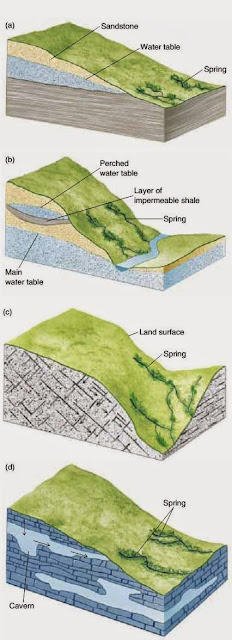Groundwater
Hydrogeology is the study of ground water. When a hole is drilled in the Earth's crust after a few meters to kilometres water appears. This water exists even if there is no stream or river nearby which recharge the ground but water zone is present as subsurface. Rain water percolates in the ground and reaches the vast reservoir of water. This water is clean and is used for drinking purposes.
Characteristics
Porosity and permeability
In the upper region of crust in few kilometers, bedrock and soil contains small void spaces which is filled with air or ground water. The proportional volume of these spaces are called porosity. As water fills in these pores therefore porosity is the indicator a rock or soil can hold water and permeability is the interconnection of pores so it indicates the transmission of water through the rocks. Sand and gravel have larger pores so they are the most suitable comprising of effective porosity. Clay is the vice versa because of the smaller pores which can store but do not transmits with no effective permeability.
Water table
When it rains so the water soaks in the soil same like sponge soaking water. These rain droplets then descends in the crust but a few kilometers in the Earth's crust due to above lying over burden pressure, the pores are closed. The closing of pores makes it nonporous and impermeable which is called bedrock. Bedrock acts as barrier so soil and rocks above it are wet and is called zone of saturation. On its top is the water table and above water table is zone of aeration where it is moist but not saturated. Water is pulled downward by gravity action but due to electrical charges between clay and water particles it moves against gravity in small channels called capillary action. Soil moisture belt is the top soil capability where humus presence keep it moist which is greater than unsaturated zone. Aquifer is the body of rock and soil which can provide economical significance of water, it is both porous and permeable which allows water to be extracted from a single well.
Movement of ground water
Water flows through ground and flow rates depends upon permeability of the rocks. Aquifer are sponge like body through which water seeps. Ground water movement can be rapid if the rock is fractured. Osmosis is a process in which water flows from area of highest water table to lowest water table areas. The above figure shows the movement of water. In (a) water recharges the stream as water table in the ground is higher than that of the stream and in (b) stream recharges the ground water. Streams flows through many valleys because of the high ground water table which continuously recharge stream and this is the factor which allows stream flowing even if it not rains for weeks or months. The stream which is recharged by the ground water is called effluent stream. In desert areas the water table is low so streams recharges the ground water and theses streams are called infuent streams.
Springs
A spring occurs when ground water intersects the surface and water seeps through and flows on land. Above the water table in hill mostly the water is trapped by an impermeable layer and water flows from them, this is called perched aquifer.
Artesian wells
An inclined aquifer where its top and bottom is bounded by impermeable layer is an artesian aquifer. The underlying water is pressurized by the above water so when well is drilled the water comes out without being pumped this is called artesian well.
Ground water depletion
When water is pumped at high rate than of water inflow to the well, a cone of depletion appears. This cone can disappear if the pumped is turned of and water in a few weeks recharges the water table below well. If the water is pumped more rapidly or if there are many wells pumping from the same aquifer than the water table will drop down. By the new technologies, high efficiency pumps production where it can pump rapidly than that of the aquifer recharge, it will deplete.













ليست هناك تعليقات:
Write التعليقات